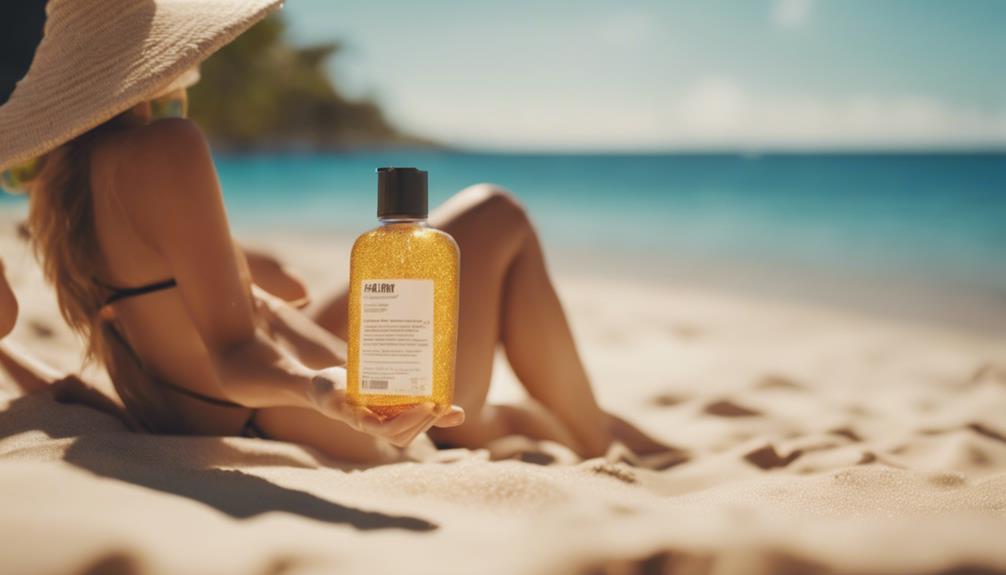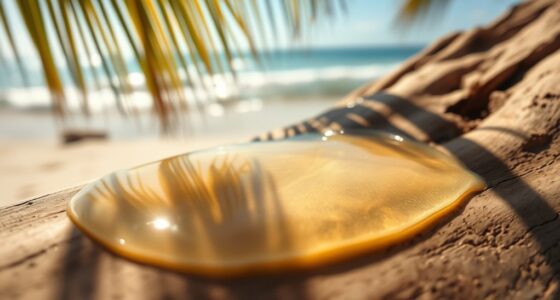You might be surprised to learn that chocolate doesn't actually cause acne. Studies show no direct link between chocolate consumption and breakouts. In fact, it's often the sugar and dairy in chocolates that could contribute to skin issues. Dark chocolate, rich in antioxidants, may even promote skin health. While moderation is key, enjoying a small amount can be beneficial. It's important to reflect on your overall diet, as high-glycemic foods are more likely to worsen acne. Curious about how different types of chocolate affect your skin? There's plenty more to uncover about maintaining clear skin and enjoying treats.
Key Takeaways
- Research shows no direct link between chocolate consumption and acne; factors like sugar and milk are more influential.
- Dark chocolate contains antioxidants that may promote skin health and reduce inflammation.
- High-glycemic index foods, especially sugary chocolates, can trigger insulin spikes that worsen acne.
- Moderation is essential; excessive chocolate intake can negate its skin benefits and potentially lead to breakouts.
Understanding the Chocolate Myth
Understanding the chocolate myth is vital for debunking the misconceptions that link chocolate consumption directly to acne. Many people believe that indulging in chocolate will lead to breakouts, but research suggests otherwise. Historical studies often failed to account for other factors, like high sugar and milk content, which complicate their findings.
A 2012 study involving 44 young adults found no correlation between chocolate and acne, emphasizing the need for more solid evidence to support this myth. Recent reviews reveal that dermatologists agree: occasional chocolate consumption doesn't necessarily lead to skin issues.
Instead, it's often the dietary context surrounding chocolate that plays a more significant role in acne development. For instance, chocolate's glycemic index is relatively low compared to sugary snacks, meaning its impact on insulin levels—and consequently on acne—may be less pronounced than previously thought.
Individual responses can vary, so it's important to evaluate your overall diet rather than focusing solely on chocolate. By recognizing these facts, you can better navigate the myths and enjoy chocolate without the fear of breakouts.
The Acne-Fighting Compounds in Chocolate

When you think about chocolate, it's easy to overlook its potential benefits for your skin.
Dark chocolate, rich in antioxidants like flavonoids, can actually help reduce inflammation and improve overall skin health.
Plus, cocoa's anti-inflammatory properties may further support your skin in the fight against acne.
Antioxidants in Chocolate
Dark chocolate's rich content of antioxidants, particularly flavonoids, plays an essential role in promoting skin health and potentially combating acne. These powerful compounds help protect your skin from oxidative stress, which can damage cells and accelerate aging.
By incorporating antioxidants in chocolate into your diet, you may notice improvements in skin hydration and blood flow, significant factors for maintaining a youthful appearance.
Research supports that consuming cocoa flavonoids can enhance skin density and hydration, which are critical for overall skin condition. A 2018 study highlights how these antioxidants can positively impact your skin, suggesting that they could aid in healing and revitalization.
In addition, while antioxidants can help reduce inflammation, a known contributor to acne, it's important to remember that moderation is key.
Cocoa's Anti-Inflammatory Properties
Harnessing cocoa's anti-inflammatory properties can be a game-changer in managing acne and promoting healthier skin. The flavonoids found in cocoa work wonders by reducing inflammation, which is often a key player in acne development. A 2013 lab study even suggested that the antioxidants in cocoa could help mitigate the immune system's overreaction that leads to those pesky acne flare-ups.
If you opt for dark chocolate, with its higher cocoa content, you're likely to reap even more benefits. The increased levels of these beneficial compounds can enhance skin hydration and density, contributing to overall skin health.
What's more, research shows that cocoa doesn't increase sebum production, a primary factor in acne development. This means that instead of exacerbating your skin issues, cocoa's compounds may actually offer protective benefits.
Chocolate's Role in Skin Clarity

Chocolate's impact on skin clarity isn't as straightforward as many believe, with various factors influencing its role in acne development. While some claim that chocolate causes acne, research shows that it's often the added ingredients, like sugar and milk, that may be responsible for skin issues. A 2017 study indicated that college students had more acne lesions after consuming chocolate than other sugary snacks, suggesting that the effect of chocolate consumption can vary widely.
Here's a closer look at the emotional side of chocolate and its impact on your skin:
| Positive Associations | Negative Experiences |
|---|---|
| Indulgence and pleasure | Breakouts and frustration |
| Moments of joy with friends | Confusion over dietary choices |
| Celebrations and treats | Anxiety about skin health |
| Childhood memories | Social stress due to acne |
Dermatologists note that occasional chocolate consumption generally doesn't lead to breakouts, highlighting the complexity of dietary influences on skin health. So, before you swear off chocolate, remember it's just one piece of a larger puzzle!
Daily Chocolate Intake for Radiant Skin

When it comes to daily chocolate intake, moderation is key for healthy skin.
You need to evaluate not just the type of chocolate you choose but also how it fits into your overall diet.
Balancing your chocolate cravings with nutrient-rich foods can help you maintain radiant skin while enjoying your favorite treat.
Chocolate and Skin Health
Incorporating a moderate amount of dark chocolate into your daily diet can potentially support radiant skin while minimizing acne concerns. Research suggests that the link between chocolate and acne isn't straightforward; it may not be the chocolate itself that's problematic, but rather the sugar and milk often found in milk chocolate.
Dark chocolate, with its lower sugar content and lower glycemic index, could be a more skin-friendly option. A 2017 study revealed that college students saw more acne lesions after consuming chocolate compared to jelly beans, indicating that specific ingredients in chocolate might affect skin health.
It's essential to recognize that the insulin response triggered by high glycemic foods, including certain chocolate products, could contribute to acne severity. So, while chocolate isn't the sole culprit, it's wise to choose varieties that are less likely to spike your insulin levels.
For ideal skin health, focus on maintaining a balanced diet rich in fruits, vegetables, and whole grains. By doing so, you can enjoy the benefits of chocolate while keeping your skin clear and radiant. Remember, moderation is key!
Moderation Is Key
Finding the right balance in your chocolate intake can play a considerable role in achieving radiant skin while minimizing the risk of breakouts. Moderation is key, especially when considering that excessive consumption of high-glycemic index chocolate may lead to increased insulin levels, which can contribute to acne.
Here's a quick guide to help you choose your chocolate wisely:
| Chocolate Type | Glycemic Index | Recommended Daily Intake |
|---|---|---|
| Dark Chocolate | Low | 1-2 ounces |
| Milk Chocolate | High | 1 ounce |
| White Chocolate | Very High | Avoid if possible |
| Sugar-Free Chocolate | Low | 1-2 ounces |
Research suggests that dark chocolate, with its lower glycemic index, is a better choice when consumed in moderation. While some studies hint at a link between chocolate and acne, individual responses vary. As a result, incorporating small amounts of chocolate into a balanced diet rich in fruits and vegetables, along with staying hydrated, can support your skin health without considerably increasing the risk of breakouts. Enjoy your chocolate, but remember: moderation is essential!
Dietary Context Matters
Understanding how your overall diet interacts with chocolate consumption is essential for achieving radiant skin. While some studies hint at a connection between chocolate and acne, the evidence isn't definitive. Your individual dietary context plays a vital role. High glycemic index foods, often found in sugary chocolate products, can spike insulin levels, potentially worsening acne. So, moderation is key.
Opt for dark chocolate instead of milk chocolate, as it typically contains less sugar and has a lower glycemic index. This choice can help you enjoy the benefits of chocolate while minimizing skin risks. However, remember that it's not just about chocolate—your entire diet matters. A balanced diet rich in fruits, vegetables, and whole grains supports skin health and can mitigate any negative effects from chocolate.
Moreover, factors like overall carbohydrate intake and dairy consumption also influence your skin. By focusing on a balanced diet, you can create a favorable environment for your skin.
Dermatologists Prescribing Chocolate Treatments

Many dermatologists are exploring chocolate's potential benefits for skin health, particularly the antioxidant properties found in dark chocolate. They suggest that certain components in a chocolate bar, especially those with lower sugar content, may not worsen acne breakouts and might even provide skin health benefits.
Consider these points when thinking about chocolate's role in your diet:
- Antioxidants in dark chocolate can help combat skin damage.
- Moderation is key; a small amount of dark chocolate can be part of a balanced diet.
- Individual responses to chocolate vary, so pay attention to how your skin reacts.
While some studies indicate a nuanced relationship between chocolate consumption and acne, dermatologists advocate for a broader understanding of dietary influences. They emphasize the importance of considering factors like insulin response and glycemic index.
The Impact of Sugar on Acne

Sugar in your diet can greatly impact acne by triggering insulin spikes that lead to increased oil production. When you consume high-glycemic index (GI) foods, including sugary treats, your body responds by producing more insulin. This can exacerbate acne by promoting excess sebum production, which clogs your pores.
Research shows that individuals with high sugar consumption often experience more severe acne symptoms compared to those who stick to low-GI diets. The sugars found in chocolate, rather than the cocoa itself, are primarily responsible for these heightened insulin responses and their role in acne development.
If you're dealing with breakouts, you might want to monitor your sugar intake. A reduction in high-sugar foods could lead to noticeable improvements in your skin health. By cutting back on sweets, especially sugary chocolate products, you're taking a proactive step in managing acne.
It's crucial to understand that what you eat can considerably affect your skin. So, consider adjusting your diet to help keep those breakouts at bay and promote clearer skin.
Dark Chocolate Vs. Milk Chocolate

When evaluating your skin health, the choice between dark chocolate and milk chocolate can greatly impact your acne management.
Dark chocolate often contains higher cocoa content and lower sugar levels, making it a potentially better option for acne-prone individuals. On the other hand, milk chocolate typically includes more sugar and dairy products, which can trigger acne flare-ups for some people.
Here are a few key points to take into account:
- Dark chocolate may help reduce inflammation due to its antioxidant properties.
- Milk chocolate's dairy content could lead to increased acne lesions, as suggested by studies.
- The added sugars in milk chocolate might spike your insulin levels, aggravating acne.
While dark chocolate might seem more skin-friendly, it's important to enjoy it in moderation.
Pay attention to how your skin reacts and make adjustments as needed. Ultimately, your choice between dark and milk chocolate should align with your personal dietary needs and skin health goals.
The Importance of a Balanced Diet

A balanced diet consistently plays an essential role in maintaining healthy skin and managing acne effectively. By focusing on a variety of nutrient-rich foods, you can support your skin's health better than by singling out specific items like chocolate. High-glycemic-index foods, such as sugary snacks and refined carbs, can worsen acne, so it's important to choose lower-glycemic options.
Here's a quick look at some dietary choices that can impact your skin:
| Food Type | Good Choices | Foods to Avoid |
|---|---|---|
| Fruits & Vegetables | Berries, spinach, carrots | Canned fruits in syrup |
| Whole Grains | Quinoa, brown rice | White bread, pastries |
| Hydration | Water, herbal teas | Sugary drinks, sodas |
In addition to maintaining a balanced diet, staying hydrated is essential. Aim for 1.5 to 2 liters of water daily to keep your skin clear and well-hydrated. Regular meals with balanced nutrients help stabilize insulin levels, potentially reducing acne flare-ups linked to high insulin responses. Focus on these dietary habits, and you'll likely see improvements in your skin health over time.
Frequently Asked Questions
Does Chocolate Cause Acne True or False?
Chocolate doesn't cause acne directly. While some studies hint at a link, it's more about individual responses and other dietary factors. You should focus on your overall diet rather than just chocolate.
Is It True That if You Eat Chocolate You Get Pimples?
You might think munching on chocolate instantly leads to pimples, but that's not true. It's more about your overall diet and skin sensitivity. Enjoy chocolate occasionally; just keep an eye on your overall intake.
How Bad Is Chocolate for Your Skin?
Chocolate's impact on your skin varies. While it doesn't directly cause acne, sugary varieties might trigger breakouts. Opt for dark chocolate in moderation, and focus on your overall diet for better skin health.
How to Eat Chocolate Without Getting Acne?
Studies show that 45% of people notice skin changes with chocolate consumption. To enjoy chocolate without breakouts, choose dark varieties, eat in moderation, pair with low-glycemic foods, and stay hydrated to support clear skin.
Are There Other Myths About Skincare and Health That Can Be Debunked Like the Myth About Chocolate and Acne?
There are numerous myths about skincare and health that can be debunked, just like the myth about chocolate and acne. One popular misconception is that smiling causes wrinkles. However, smiling actually has numerous mental and physical benefits, and there is no evidence to suggest that it directly causes wrinkles.
Conclusion
So, the next time someone blames chocolate for your breakouts, you can confidently tell them they're completely off base!
In fact, indulging in dark chocolate might just be the secret weapon your skin's been waiting for.
Imagine a world where you can munch on rich, velvety chocolate and actually boost your skin's health.
It's practically a miracle!
Embrace that sweet treat, balance it with a nutritious diet, and watch your skin glow like never before!









